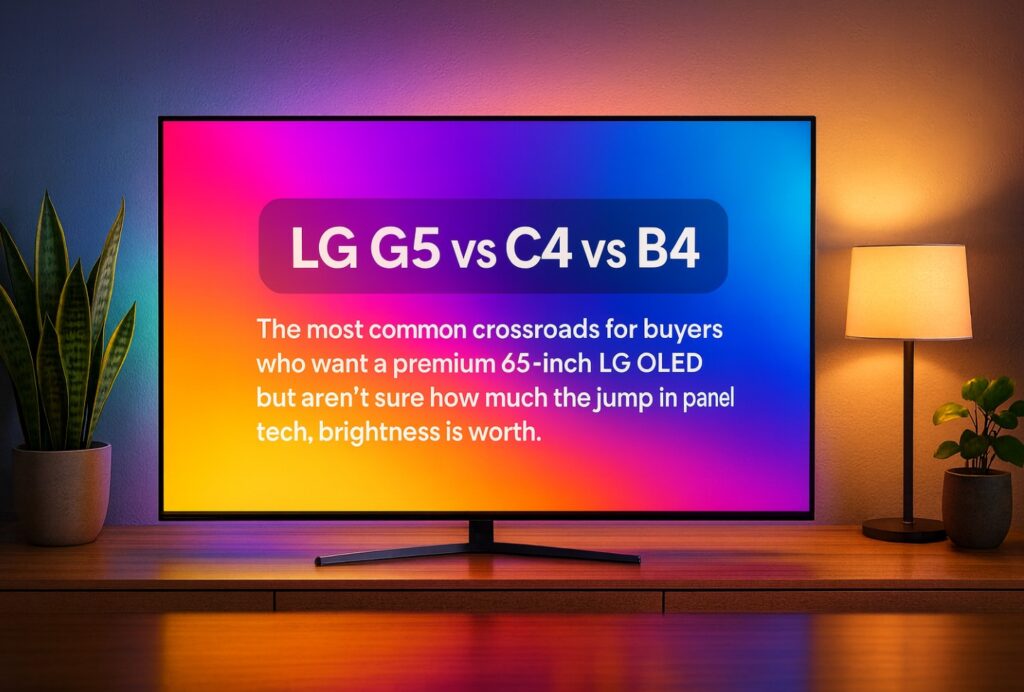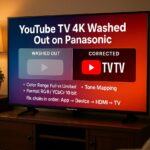LG G5 vs C4 vs B4 is the most common crossroads for buyers who want a premium 65-inch LG OLED but aren’t sure how much the jump in panel tech, brightness, and gaming matters in real rooms. This guide cuts through the noise with verified specs, a “manufacturer claims vs rounded independent measurements” table, clean port-by-port I/O maps, and straight advice on who should pick each model. (webOS on all three; G5/C4 step up in processing and refresh rate; B4 focuses on value.)
LG G5 vs C4 vs B4: Key Differences and Similarities
- G5 (65″): Primary RGB Tandem OLED panel, α11 Gen2, the brightest LG OLED here, 4× HDMI 2.1 up to 4K165Hz; eARC on HDMI 2; “wall-first” design. Ideal if you want the punchiest HDR and next-gen gaming headroom.
- C4 (65″): OLED evo with α9 Gen7, excellent 4K144Hz, 4× HDMI 2.1, fantastic all-rounder value. If you game on PS5/PC and watch movies at night, this is the sweet spot. LG IT
- B4 (65″): OLED value play, 4× HDMI 2.1 at 4K120, great contrast and features but lower HDR peaks; eARC on HDMI 3. Best for cinema nights and console gaming at 120Hz.
Main Comparison Table (65″)
| Feature | LG G5 (65″) | LG C4 (65″) | LG B4 (65″) |
|---|---|---|---|
| Panel Technology | Primary RGB Tandem OLED (four-stack) | OLED evo | OLED |
| Processor | α11 AI Processor Gen2 | α9 AI Processor Gen7 | α8/series processor (B-class) |
| Peak Brightness (manufacturer claim) | Up to ~45% brighter vs B-class at 10% APL (internal LG claim) | “Brighter than before” OLED evo | Standard OLED (no “booster” claim) |
| Peak Brightness (rounded independent) | ≈2,300+ nits highlights; very strong full-field for OLED | ≈1,000–1,200 nits highlights | ≈600–700 nits highlights |
| Refresh Rate | Up to 4K165Hz | Up to 4K144Hz | Up to 4K120Hz |
| HDMI 2.1 ports | 4 (48 Gbps; eARC on HDMI 2) | 4 (eARC typically on HDMI 2) | 4 (eARC on HDMI 3) |
| VRR / G-Sync / FreeSync | Yes / Yes / Yes | Yes / Yes / Yes | Yes / Yes / Yes |
| Smart Platform | webOS (latest) | webOS (latest) | webOS (latest) |
| Design intent | Gallery (flush mount first) | Stand or wall | Stand or wall |
Design & Build Quality
G5’s Gallery design is made to sit flush on the wall (pedestal solutions exist but the aesthetic is wall-first). C4/B4 are more flexible out of the box for media stands. Cable management is straightforward on all three; G5 places eARC on HDMI 2, B4 on HDMI 3, which matters if your soundbar/AVR dictates cable runs.
Panel Technology Explained
- G5 (Tandem OLED): Uses a Primary RGB Tandem stack (four-layer emission) that boosts luminance efficiency without sacrificing black floor — the key reason it reaches the highest peaks here. If you want OLED contrast and punch for bright rooms, this is the LG to beat.
- C4/B4 (WOLED family): Both use LG’s established OLED architecture; C4 adds OLED evo refinements plus stronger processing to lift HDR pop, while B4 keeps the essentials for value buyers.
Brightness & HDR Performance
- G5 delivers the brightest specular highlights and better large-area brightness than prior generations, so daylight HDR holds up better. Dolby Vision and HDR10 content both benefit from the extra headroom.
- C4 is bright enough for mixed lighting and cinema nights, and its tone mapping is mature.
- B4 looks excellent in dim to moderately lit rooms; in harsh daylight you may notice less “sparkle” in HDR.
Claims vs rounded measurements are summarized in the table above to help set expectations realistically for living rooms, not just lab charts.
Color Accuracy & Picture Processing
- G5 moves to α11 AI Processor Gen2, improving upscaling and texture handling; C4 runs α9 Gen7 — already excellent for mixed content. B4’s processor is simpler but accurate out of the box in Filmmaker/Cinema.
Motion Handling & Refresh Rates
- G5: up to 4K165Hz — a niche bonus for high-end PCs, still great at 120Hz for consoles.
- C4: up to 4K144Hz, the practical sweet spot for PC + console owners.
- B4: 4K120Hz covers PS5/Series X perfectly; motion remains class-leading thanks to near-instant pixel response.
Gaming Features
All three support VRR (HDMI Forum + AMD + NVIDIA), ALLM, and extremely low input lag. If you plan to calibrate HDR via HGiG on consoles, G5/C4 give you finer headroom for highlight detail without crushing near-black; B4 still looks superb after a proper HGiG setup.
Smart Platform & UX (webOS)
All three run webOS with Game Optimizer/Dashboard, excellent app support, and long-term update policies (model-dependent). C4/G5 add the latest UI refinements and performance tweaks; B4 remains responsive in day-to-day use. For official specs and feature notes, see LG’s G5 product page (single external reference).
Audio & Connectivity
- HDMI: 4× HDMI 2.1 on all three. G5 eARC: HDMI 2; B4 eARC: HDMI 3; C4 eARC is typically on HDMI 2.
- Other I/O: 1× Ethernet, 2× USB (varies by region), RF tuner, optical out on most SKUs.
- Sound: Dolby Atmos passthrough via eARC; pairing with an eARC soundbar/AVR is straightforward once you set Sound Out → Pass Through and verify CEC (SIMPLINK).
Port-by-Port I/O Maps (65″, typical regional SKUs)
LG G5 (65″) — rear/side
HDMI 1 (2.1), HDMI 2 (2.1, eARC), HDMI 3 (2.1), HDMI 4 (2.1), Ethernet, USB-A ×2, RF in, Optical out.
LG C4 (65″) — rear/side
HDMI 1 (2.1), HDMI 2 (2.1, eARC), HDMI 3 (2.1), HDMI 4 (2.1), Ethernet, USB-A ×2, RF in, Optical out.
LG B4 (65″) — rear/side
HDMI 1 (2.1), HDMI 2 (2.1), HDMI 3 (2.1, eARC), HDMI 4 (2.1), Ethernet, USB-A ×2, RF in, Optical out.
Thermal Design & Longevity
G5’s tandem stack increases efficiency at a given luminance, which helps with heat management during bright HDR scenes; normal OLED care still applies (Pixel Refresher, logo dimming). C4/B4 follow LG’s proven playbook for burn-in mitigation and panel maintenance.
Real-World Impressions
If you watch a lot in daylight and want OLED contrast with “LCD-like” punch, G5’s extra headroom is noticeable. In a dim room, C4 and even B4 deliver gorgeous, cinematic images—C4 adds more pop for mixed lighting and fast gaming. 🎬🎮✨
Common Mistakes to Avoid
- Enabling tone-mapping on both TV and console/box at the same time.
- Leaving Energy Saving on during HDR (dims the image).
- Using “Full” RGB on the console while the TV expects “Limited,” causing washed blacks. ⚠️
Who should buy which?
- Buy G5 if you want the brightest LG OLED with future-proof gaming (165Hz PC, four full HDMI 2.1), and you often watch in brighter rooms.
- Buy C4 if you want the best price/performance balance for movies + gaming (144Hz PC, four HDMI 2.1).
- Buy B4 if you’re mainly watching at night, game at 120Hz, and want to save money without sacrificing OLED contrast.
FAQ
Is the LG G5 (65″) really using a tandem OLED panel?
Yes — the 65″ G5 employs a Primary RGB Tandem (four-stack) OLED, enabling higher luminance efficiency and peak brightness than C4/B4.
Which model is best for a sunny living room?
G5, thanks to the tandem stack’s extra headroom and stronger full-field brightness for HDR scenes.
Do all three have HDMI 2.1 on every port?
Yes — four HDMI 2.1 on G5, C4, and B4; refresh ceilings differ (G5 165Hz, C4 144Hz, B4 120Hz).
Where is eARC on each TV?
G5: HDMI 2; C4: typically HDMI 2; B4: HDMI 3. Check your back panel labeling to confirm.
Does C4 feel dim next to G5?
In a bright room, yes — G5’s highlights pop more. In a dark room, C4 remains excellent and closer to G5 than specs suggest.
Is B4 good for PS5/Series X?
Absolutely. It handles 4K120 with VRR and low input lag. If you don’t need >120Hz PC gaming or the very highest HDR peaks, it’s a great value.
Final Verdict
If you want the most luminous OLED LG makes at 65″ with the best gaming headroom, pick G5. If you want maximum value without obvious compromises, pick C4. If budget matters and you watch mostly at night at 120Hz, B4 delivers the OLED look you came for — beautifully. 🌙🕹️💡
External source (inline, clean URL): Official LG G5 product page — specs & features (for reference while shopping). LG IT
Recommended internal reads (live on TVComparePro):


